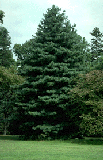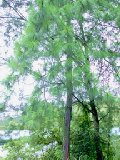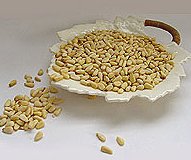Pine Nut
http://www.100md.com
《e Natural Health Center》
 |
 |
 |
 |
Nuts and Seeds
Pine Nut
Latin:
Pinus koraiensis and Pinus massoniana
Origin:
The seed of any of about 90 species of ornamental and timber evergreen conifers, but particularly of the species Pinus koraiensis Siebold. & Zucc. (Korean Nut Pine), and Pinus massoniana Lamb. (Chinese Red Pine), of the family Pinaceae. The plant Pinus koraiensis is native to Korea, also to Amur region of China and Japan. Pinus massoniana is native to China, and is grown in Taiwan, and in the provinces Anhui, Fujian, Guangdong, Guangxi, Guizhou, Hainan, Hubei, Hunan, Jiangsu, Jiangxi, Shaanxi, Sichuan, Yunnan, and Zhejiang. This species is also planted in some provinces of Vietnam. It occurs from plains to mountains, from near sea level to 2,000 m elevation.
, 百拇医药
Pine trees as a whole, though, are distributed throughout the world. There are several varieties of pine trees that produce pine nuts, including the umbrella pine or stone pine. Most edible pine nuts grow in Southern Europe, particularly Italy and France, although some also grow in Spain, Portugal, and the southern United States.
Young pine trees are usually conical, with whorls of horizontal branches; older trees may have round, flat, or spreading crowns. Most species of pine trees have thick, rough, furrowed bark. Pine trees can tolerate drought but require full sunlight and clean air for good growth and reproduction.
, 百拇医药
Pines have two types of branches, long shoots and short shoots, and three types of leaves, primordial, scale, and adult.
In spring or early summer the pollen sacs release pollen through longitudinal slits; each grain has two air bladders for wind dispersal. The scales on the female cones open to receive the pollen and then close; actual fertilization takes place late the following spring. After fertilization, the woody female cone develops over a two- to three-year period. In some species, the cones open at maturity and the seeds are released; in others the cones remain closed for several years until opened by rotting, by food-seeking animals, or by fire. In some pines the scale bearing the nutlike seed may be expanded to form a wing for airborne dispersal.
, 百拇医药
Pines are softwoods, but commercially they may be designated as soft pines or hard pines.
Edible pine nuts are sold commercially as pine nuts, pinons, or pignons, produced by stone, Armand, Siberian, pinon, Torrey, Coulter, and digger pines. Shelled pine nuts are widely available year-round.
Other values of pines are in the construction and paper-products industries, but they are also sources of turpentine, rosin, oils, and wood tars (naval stores). Charcoal, lampblack, and fuel gases are distillation by-products.
, 百拇医药
Pine-leaf oil, used medicinally, is a distillation product of the leaves. Many species of pines are cultivated as ornamentals, including black, white, Himalayan, and stone pines. Others, such as Scots, Corsican, cluster, and knobcone pines, are planted in reforestation projects or for windbreaks.
Properties:
Sweet in flavor, mild in nature, it is related to the channels of the liver, lung and large intestine.
, http://www.100md.com
Functions:
Promotes the production of yin (body fluid), arrests convulsion, moisturizes the lung and lubricates the intestinal tract.
Applications:
Pine nut is used as a cure of migratory arthralgia, vertigo, dry cough, hemoptysis (expectoration of blood from some part of the respiratory tract) and constipation.
Dosage and Administration:
, http://www.100md.com
Pine nuts can be eaten raw or roasted. Raw pine nuts are creamy white and have a slightly resinous flavor that is eliminated by roasting. Raw pine nuts are ground and used to make Italian pesto sauce. Pine nuts can be roasted in a 180° C oven or on top of the stove until golden brown. Pine nuts are used in salads, stuffing, and other savory dishes, and can be used to make cookies, breads, and desserts.
Since pine nuts are often harvested by hand, they are often very expensive. Pine nuts are invariably sold shelled and raw. Since they go rancid quickly, be sure to buy them in stores with a quick turnover rate. Raw pine nuts should be stored in a tightly sealed container in the refrigerator where they will keep for up to one month. In the freezer, pine nuts will keep for up to three months.
, 百拇医药
Cautions on Use:
Pine nut should be avoided by those who are troubled with loose stools, spermatorrhoea or phlegm-dampness.
The wood, sawdust and resins from various species of pine can cause dermatitis in sensitive people.
Alpha-linolenic acid is a fatty acid found in many foods. Most, but not all, studies have found that high dietary or blood levels of alpha-linolenic acid correlate with an increased risk of prostate cancer. Concentrations of alpha-linolenic acid are high in pine nuts, almonds, Brazil nuts, cashews, flaxseed, hazelnuts, macadamia nuts, peanuts, pecans, pistachios, and walnuts.
, 百拇医药
Reference Materials:
Toxic or Side Effects:
Modern Researches:
Pine nut contains 74 percent of fatty oil (mainly olein, linolein), palmatine, protein, essential oil.
The turpentine obtained from the resin of all pine trees is antiseptic, diuretic, rubefacient (an external application which produces redness of the skin) and vermifuge (expels worms from animal bodies). It is a valuable remedy used internally in the treatment of kidney and bladder complaints and is used both internally and as a rub and steam bath in the treatment of rheumatic affections. It is also very beneficial to the respiratory system and so is useful in treating diseases of the mucous membranes and respiratory complaints such as coughs, colds, influenza and TB. Externally it is a very beneficial treatment for a variety of skin complaints, wounds, sores, burns, boils, etc., and is used in the form of liniment plasters, poultices, herbal steam baths and inhalers.
, 百拇医药
The chopped or decocted leaves are used in the treatment of rheumatism and intestinal parasites.
The pollen is cardiac and astringent.
The wood of the stems is carminative (relieves flatulence) and demulcent.
The stembark is astringent, parasiticide and vulnerary (adapted to the cure of external injuries).
The rootbark is astringent and tonic.
, http://www.100md.com
A tan or green dye is obtained fron the needles.
The needles contain a substance called terpene, this is released when rain washes over the needles and it has a negative effect on the germination of some plants, including wheat.
Oleo-resins are present in the tissues of all species of pines, but these are often not present in sufficient quantity to make their extraction economically worthwhile. The resins are obtained by tapping the trunk, or by destructive distillation of the wood. In general, trees from warmer areas of distribution give the higher yields. Turpentine consists of an average of 20 percent of the oleo-resin and is separated by distillation.
Turpentine has a wide range of uses including as a solvent for waxes, etc., for making varnish, medicinal, etc. Rosin is the substance left after turpentine is removed. This is used by violinists on their bows and also in making sealing wax, varnish, etc. Pitch can also be obtained from the resin and is used for waterproofing, as a wood preservative, etc., http://www.100md.com